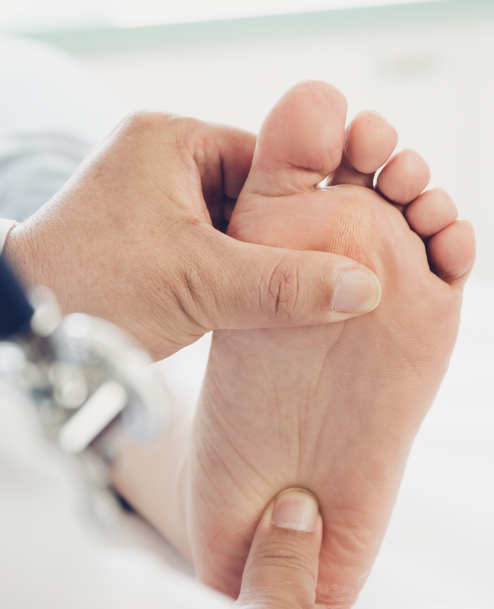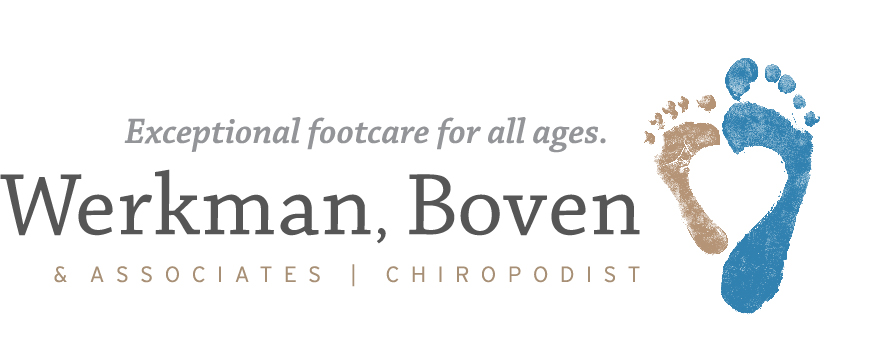Foot Related Conditions
Heel, Arch, Knee, & Foot Pain
Often when a person experiences heel, arch, knee or foot pain, it is associated with complications of poor foot function. Typically, an orthotic is the prescribed medical device to address these issues. An orthotic is custom-made and is uniquely designed for your foot. For this reason, an orthotic is not the same as over-the-counter arch support.
Book an appointment to have a registered chiropodist assess whether an orthotic is a good fit for your feet!
did you know?
Only a small percentage of the population is born with foot problems. It’s neglect, lack of awareness and ill-fitting shoes that create preventable problems.
Workplace Athletes
Your ability to use your feet with ease and comfort is vital if you want to remain a valuable and productive worker. However, many workers are exposed to injuries due to prolonged periods of standing and walking. For example, a person who picks orders in a warehouse may walk up to 15 kilometres or more in an eight-hour shift. Another worker in the same warehouse may be required to stand in one position for at least six hours during a shift. These individuals are often thought of as workplace athletes, especially when considering that these workers perform the same tasks five to six days a week, often working overtime. Workplace athletes are susceptible to many of the same types of overuse injuries, such as regular athletes. Postural and foot pain are frequent complaints, in addition to an increase in callus formations and ingrown toenails. Many careers employ workplace athletes.
Some of them include:
- Postal workers
- Bank tellers
- Parking meter attendants
- Teachers or lecturers
- Cashiers
- Factory workers
- Construction workers
- Nurses
What are the Risk Factors?
What are the risks for non-traumatic lower extremity or back injury on the job?
- Individuals who engage in long periods of standing and walking are at risk for injury. But this alone cannot explain why some individuals suffer injuries, and others do not.
- The type of job and the flooring can be potential risk factors. For example, jobs that do not allow individuals to switch among several positions may have higher risks.
- The type of shoes worn is also a consideration. Poorly fitted shoes and work boots may aggravate calluses and ingrown toenails. They may also accentuate a structural abnormality of the foot.
- Obesity is another potential risk because it affects the forces exerted on the spine and lower extremity joints during walking and standing.
- Previous injury to a specific area that never really recovers may also risk chronic workplace injury.
- Perhaps the most significant risk is structural abnormality of the foot and lower extremity, such as a flat foot, excessive pronation or supination.
You can’t take your feet for granted. Your concern for them should continue on and off the job.

What can your Chiropodist do?
A Chiropodist can treat foot problems of the workplace athlete.
- Help you pick the right shoes. Ill-fitting footwear (including work boots) and poor foot structure may cause corns, calluses and ingrown toenails.
- Regular, routine treatment can easily relieve the pain and discomfort caused by corns and calluses.
- Ingrown toenails can also be managed with regular treatments. Surgical removal of all or part of the toenail by a registered Chiropodist is a more permanent alternative.
More complicated problems such as heel, knee or back pain require an additional evaluation by the Chiropodist to determine the underlying factors causing the pain. These types of problems often require a combination of treatments which may include:
- Magnetic Biostimulation Therapy
- Custom-made Orthotics
- Therapeutic Footwear
- Nail Surgery
- Icing the affected area
- Strapping
- Referral to other medical disciplines
What can you do to prevent complications?
The best treatment plan for any foot problem is prevention. Most foot problems can be avoided by following these simple recommendations:
- Bathe your feet daily and dry them thoroughly.
- Check your feet frequently for corns, calluses and cracks.
- Keep your feet warm.
- Trim your toenails straight across, slightly longer than the end of the toe.
- Proper fitting footwear considering both length and width.
At the first sign of a problem, see your Chiropodist. Don’t wait until it’s too late!
Articles of Interest
Heel, Arch, Knee & Foot Pain
It seems like a lot to cover in a .....
Your Body Takes Care of Itself: Healing & MBS
Your body is the only thing standing between you .....
Keep Your Feet on the Ground…and Keep Them Healthy!
Feet are designed to carry us to the places we .....

